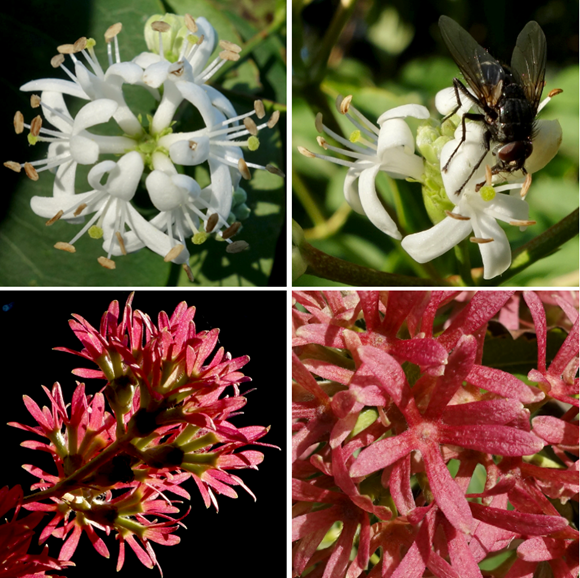One of the most wonderful flowering events at the Arnold Arboretum happens in the late summer and fall. Seven son flower, Heptacodium miconioides, is one of the great horticultural introductions into North America from China. And of course, the Arnold Arboretum had a hand in this introduction while participating in the 1980 Sino-American Botanical Expedition. This notable expedition marked the first time since the Communist revolution in 1949, that the Arboretum had been back to China to collect plants (seeds).
These large shrubs essentially flower twice (visually speaking). In late summer and early fall, the plants produce a profuse set of white flowers (upper left, 425-91*B). Bees show up and do their pollinating thing. So do flies (upper right, 181-96*C ) and other insects. The attractive flowers then drop their white petals (collectively, the corolla) and stamens (pollen producing organs) and all that remains are the ovary (which will develop into the fruit) and the sepals. The sepals (the outermost whorl of a flower; collectively, the calyx) are super tiny and green. But if the flower has been pollinated, they immediately begin to expand from perhaps a half millimeter in length to well over a centimeter. Along the way, these sepals also transition from green to deep crimson red (lower images; 425-91*B and 425-91*D); in essence a second flower show that will last well into November. Why the sepals grow and turn red (fill with anthocyanin pigments) as the small fruit develops is anyone’s guess.

Seven son flower is a seriously endangered species, but the plants can be easily obtained in the nursery trade and make a fantastic addition to any garden for late summer and fall interest. In the winter, the beautiful peeling bark is also magnificent. So, come admire the seven son flower shrubs at the Arnold Arboretum now and into November for their red sepals. You will have to wait until next year to see the flowers in white.
Here is a great short read on the history of collecting Heptacodium.
